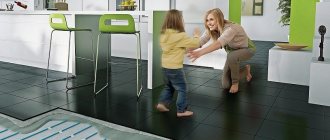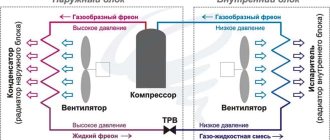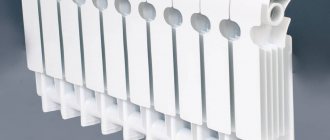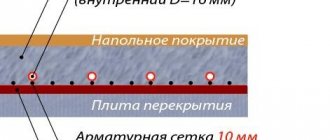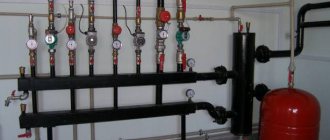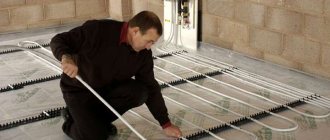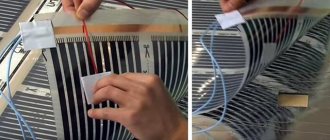Cause of cold floors
The radiators are hot, you can’t touch them with your hand, and you have to walk around the apartment in woolen socks or slippers. The fact is that the radiators heat the places located near them, the heat, according to the law of physics, rises and circulates closer to the ceilings, while the floors remain cold.
Even installing additional radiators will not save you from this situation; the apartment will become hot, dry, and there will not be enough oxygen for proper breathing.
Warm floors - pros and cons
The most significant advantage of a modern underfloor heating system is the significant savings on heating. In addition, the obvious advantages of the presented system are expressed in:
- High level of thermal comfort;
- Relatively low temperature of heating elements;
- The absence of bulky radiators that require additional decoration for visual “camouflage”;
- Wide range of thermal control functions;
- Long service life (up to 30 years);
- Ability to quickly repair local faults.
Along with this, the underfloor heating system has its disadvantages. They are expressed in the following:
- If you spend a long time in a room (bedroom, kitchen, living room) with a high temperature of the floor covering, a warm floor can provoke an exacerbation of vascular diseases of the legs;
- When using additional coating in rooms, the heat transfer resistance coefficient of the material should not exceed 0.15 m2*K/W;
- A warm floor in an apartment does not heat up instantly, and in order to completely heat the room, some varieties will need about 10-12 hours;
- There is a need to raise the floor by 6-10 cm during installation;
- Warm floors in the kitchen, as in other rooms, can negatively affect plastic furniture installed on top, which, when heated, can release harmful volatile compounds.
Limitations for additional heating
But for installing heated floors in apartments there are restrictions from SanPi.
In standard city apartments, replacing batteries with heating with water is not allowed, since connecting to central heating is impossible. This is prohibited by the housing code, and the neighbors below will not give consent.
Residents of the first floor, if no one lives below and there are no industrial premises, can allow floor heating using hot water in pipes. In private houses with individual autonomous heating, water heating is permitted; this is an excellent option for them.
We recommend: What are the advantages of a heated metal-plastic floor?
Preparing and connecting the collector
The collector helps to distribute the coolant evenly, especially when installing heated floors in several rooms.
Assembly according to the diagram:
- Installation of the frame. There are no specific instructions for this step other than the note that the installation must be horizontal. The frame can be in a closet or a wall.
- Connection to the boiler. The feed is fixed at the bottom, the return at the top.
- Installation of a valve that controls the heat supply.
- Installation and connection of the collector itself.
There is no need to be afraid to turn on the heated floor in order to check whether the connection was made correctly. If something goes wrong, the collector simply will not start.
Additional sensors that monitor the operation of the entire system are called flow meters.
- Establish a uniform distribution of heat throughout the heated rooms.
- They are energy saving devices.
- Improves conductivity along all circuits.
Do you need underfloor heating?
Of course we need it.
Firstly, these floors are more energy efficient. They heat a larger area at lower costs.
Secondly, such floors evenly heat the air over the entire area of the room without drying it out and eliminate humidity.
Thirdly, without heating devices, the interior of the room looks completely different, it is easier to clean, there is no source of dust “in the accordions” of the radiator.
When the room is heated from below, from the floor, then much less energy from electrical appliances will be required to warm the room, and the effect will be greater.
This means that this proves that underfloor heating is more effective than batteries of the same type. Heating a room using water is much more effective than standard radiators in apartments; electric mats, cable, and infrared film heat the room better than electric radiators.
Features of rod heated floors
Carbon (rod) flooring can be made to match tiles and any other types of flooring. It is also combined with laminate, parquet, and wood. The design is presented in the form of a heating mat, which consists of carbon rods with a thickness of 0.3 cm and a length of 0.83 cm. The rods are connected to each other using a power cable in a parallel circuit. The warm carbon floor system has its advantages and disadvantages. The advantages are that:
- The technology allows heating the room using infrared waves;
- The warm carbon mat is versatile and can be combined with any decorative floor covering;
- Since the structure is connected in parallel, the heating mats can be divided into any number of sections, which is especially important in rooms with a complex layout, for example, in a bedroom;
- The presented heating system can be adjusted automatically. Carbon rods adapt to areas of the floor with different temperatures and provide uniform heating over the entire area. In some areas (cold) the temperature increases, and in warmer areas it decreases;
- The service life of the heating circuit can be 10-15 years.
Along with this, rod heated floors have their drawbacks. You can install a carbon mat only in a layer of tile adhesive, otherwise you need to make a thin cement screed. Despite its rather long service life, the system is not mobile - it can only be permanently installed.
Advantages of heated floors
- They create comfort, they especially help out when the central heating is turned off early in the spring and turned on late in the fall;
- The general appearance of the interior looks aesthetically pleasing, the wires are not visible, they remain under the floor covering;
- Environmentally safe and harmless;
- Characterized by versatility. They can be equipped with any floor covering: linoleum and parquet, laminate and ceramic tiles;
- The heating mode can be adjusted with a special thermostat;
- Good for the health. In rooms with heated floors, adults and children are rarely exposed to colds.
Is underfloor heating harmful to health?
The idea of the dangers of heated floors is associated with electromagnetic radiation. An electric heated floor, like every electrical appliance, does have it, but it is within normal limits. A more noticeable problem is dry air in the room where heated floors are installed. However, this issue can also be resolved by installing a humidifier.
A heated floor can only be truly harmful if it is installed incorrectly:
- If an unsuitable material is used as a finishing coating.
- If you skimped on thermostats during installation, this causes the floor to dry out the air.
In what areas of the apartment do you need heated floors?
The area covered with ceramic tiles requires mandatory heating.
Bathroom
Walking barefoot on cold tiles in the bathroom is not entirely pleasant. Although the air in the bathroom becomes warm from the steam of hot water, you can catch a cold after taking water procedures, this is especially true for small children.
Kitchen
Warm floors are essential in the kitchen. A woman spends several hours in it when preparing food, and she requires comfortable conditions.
Children's
The third place in the apartment where floor heating needs to be installed is the children's room, if the flooring is laminate or linoleum. Children love to play on the floor and then often get cold.
We recommend: How to lay a heated floor with a snail?
It is necessary to install heated floors in the nursery to preserve the health of the children. It is recommended to install infrared film in the nursery; unlike others, it does not require a concrete screed.
Loggia
On an insulated balcony or loggia, it is imperative to install heated floors.
The floors in the loggia, even if it is insulated, are always cold. Heaters will not be able to provide her with the necessary heat. The floors will be so cold that even wool socks will be uncomfortable.
And no heating device can warm them up, because heaters heat the air around them, and the heat goes up to the ceiling.
Hallway
After a cold street, finding yourself in a hallway with warm floors is very pleasant for your feet. The air from the floor heating will be a kind of thermal curtain from the cold air from the hallway doors. And the shoes here will dry by morning without any additional hassle.
Living room
When at home, people spend most of their time in the living room. Sitting on the sofa, they read books in an armchair, watch TV, and do their favorite things in their spare time. Guests are received here, some of whom may be susceptible to colds.
It is recommended to install heated floors in the living room not over the entire area of the room, but only in places where people will be. That is, you should not install room heating devices under sofas, armchairs and other furniture.
Which heated floor to choose for an apartment
Each type of heated floor has its own limitations. For example, a liquid floor cannot be placed above living spaces, and heavy objects cannot be placed on a film floor. Next we will look at what kind of warm floor can be used depending on the finish coating.
Under laminate and parquet
Wood has low thermal conductivity, that is, it does not transmit heat well through itself. Therefore, it is pointless to install a warm floor under a parquet board - the heat simply cannot rise to the top. In addition, constant heating can cause parquet to become unusable.
You can use laminate flooring with heated floors, but not every type. It must have special markings: Underfloor heating (suitable for electric heating, cable or with infrared film). If you use a regular laminate, it can deteriorate from heating, it will not transmit heat well and emit harmful substances.
Under tiles and porcelain stoneware
A tiled heated floor is placed directly under the finishing coating, so it is not very suitable for tiles and porcelain stoneware. The tiles will not stick well to the floor, so they will fall off over time. For a bathroom in an apartment, the best option would be an electric cable floor, since it fits completely into the screed. The tile will hold firmly, and the cable will be reliably protected from moisture. Tile floors with open joints should not be used in wet areas.
Under the carpet
Carpet and carpet do have thermal insulating properties, so in theory, heat from the floor should go down, not up. However, in practice, the problem is solved by an additional layer of thermal insulation, which is placed under the heated floor, as well as by the thickness of the carpet. The thin coating transmits heat no worse than laminate. Also, in order to warm the floor well, you may have to increase the temperature on the thermostat.
A water-based floor is well suited for carpet, as it warms up gradually and does not damage the coating. In contrast, an electric floor heats up quickly, and this can damage the carpet. Another danger of the electrical system is burnout in places where the floor is in close contact with furniture, such as cabinet legs. The best option for carpeting would be an infrared floor.
Under linoleum
Modern linoleum can be combined with almost all types of heated floors. The main condition is the choice of the coating itself. Among the different types of linoleum, PVC linoleum and natural linoleum react least to heat. They do not deform due to temperature changes and do not emit harmful substances when heated. The best option for linoleum is considered to be an infrared heated floor.
Where are heated floors not needed?
In the bedroom a person sleeps and rests after a hard day. For a night's sleep to benefit a person, he must sleep in a cool room with a temperature within 18 degrees.
Consequently, it is impractical to install heated floors in all rooms of an apartment or house; in some places they are completely unnecessary, even harmful. The issue of additional heating using a heated floor system must be approached wisely.
In a room with dry, excessively warm air, a person will feel lethargic in the morning, and some will suffer from headaches. Therefore, the only place in the apartment where floor heating should be abandoned is the bedroom.
We recommend: What is the pipe consumption for underfloor heating per m2?
Facts about using water heated floors
So, is it worth installing heated floors today?
Fact 1. Water-heated floors are an opportunity to save big. So, by installing this type of heating, you can significantly reduce electricity consumption by more than 20 percent. This is due to the low temperature of the coolant (about 35-50 degrees Celsius). By installing heated floors in rooms with a large area and low ceilings, you can save about 60 percent on heating. This system heats the air 2.5 meters from the floor level.
Fact 2. High level of security. All heating elements are hidden from access. Therefore, the space of a water heated floor is absolutely safe even for small children. The chance of getting burns or other types of injuries from touching a heat carrier is reduced to zero. There is no danger even with prolonged contact with the floor.
Fact 3. Comfort. The room where the warm water floor is installed is heated evenly over its entire area. Thanks to this, optimal temperature conditions are created in the room (at the level of the feet the temperature is +20-22 degrees Celsius, while at the level of the head - +18 degrees), which have a positive effect on the condition and health of a person. The warm floor is pleasant to the touch; you can safely walk on it with children and pets.
Fact 4. Use of unique technology. The room is heated by radiation rather than by convection. The principle is very similar to the work of the sun, which heats the soil and releases heat
Fact 5. Excellent quality. Warm water floors are made only from high-quality materials using modern equipment, as well as advanced technologies. Such heating systems are distinguished by their reliability, resistance to external negative factors and the possibility of long-term operation. The only elements that limit the service life of the heating system are the pipes.
We have already given 5 facts, answering your question about whether to install heated floors today. But that is not all!
Fact 6. Impeccable appearance . This is achieved due to the absence of visible elements and parts of the heating system. Projects to create a room design and its redevelopment are carried out much easier due to the fact that the devices are not visible. There are no obstacles such as radiators (if they do not fit in with the overall appearance, as well as the interior concept, replacement or the use of special decorative panels will be required).
Fact 7. Function of self-regulation of heat exchange in the room. For example, if the room temperature decreases, say, due to a wide open window, then the heat transfer of the water heated floor will be significantly increased. When heat transfer is increased due to exposure to sunlight, the heat transfer of the heating system decreases.
Fact 8. No circulation of dust and damp corners to the room . In the first case, dust will not bother the owners, which is due to the lack of air conversion. Whereas, due to the normalized state of the air, the possibility of fungus or even mold forming in the corners of the room is excluded.
Fact 9. Full compatibility of water heated floors with all kinds of heating systems (heat pumps or radiator systems).
Fact 10. Easy to maintain and use. Agree, washing floors and keeping them clean is much easier than cleaning a radiator. As for operation, there are no special requirements. It is enough to carry out periodic inspection by a specialist in order to prevent the occurrence and development of breakdowns.
Warm floors in the bathhouse
It is advisable to install heated floors in the dressing room and washing room. Why? In the bathhouse, heated floors create a comfortable microclimate during water procedures, dry the wood, preventing biological destruction from fungal plaque.
The bathhouse is characterized by high air humidity, the floors in it become very wet. To ensure the safety of walls and floors from rotting, to prevent the formation of fungi and mold, it is necessary to dry the bathhouse. Especially during the cold season, the floors even in a hot bath can be cold.
For a bath, heating using a water floor is best suited, which is mounted between the base (concrete or wood) and the floor covering.
Hot water from a gas boiler or central heating circulates through flexible polymer pipes and heats not only the floors, but also the air in the room. A water floor is economical, environmentally friendly, and contains no electromagnetic radiation.
But in winter, you need to ensure that water is drained from the pipes in a timely manner. The heat source can be used from a sauna stove. Pipes are laid with a snake, double snake, snail or corner snake.
Common features of underfloor heating systems and differences
Now stores offer different types of equipment and devices for installing heated floors in homes. You need to carefully study useful information about the system and make the right choice. Electric options have little electromagnetic radiation.
But heating cables and mats can be installed anywhere. Water-based floor heating is suitable for new buildings with autonomous heating systems or in private residential buildings.
Such floors are installed in country houses, where you can choose any system: water or electric. Water-type installation is possible under any type of floor covering.
Those who want to install additional floor heating can study video materials on the Internet.
The technology of heating rooms using heated floors will no longer surprise anyone; it has long become popular.
- Related Posts
- What types of mats are there for heated floors?
- Characteristics of Nexans underfloor heating
- What is film heated flooring?
- How to lay a heated floor without screed?
- How to install electric heated floors under tiles?
- How to choose a pump for underfloor heating?
Warm floor
5Criteria for selecting heating mats
TYPE OF PREMISES IN WHICH THEIR USE IS PLANNED
As an additional source of heat, it is best to use heated floors in the kitchen or bathroom. In the bathroom, you can plan the installation of heating mats in different ways:
| 3 square mats | 1 large mat |
2 large and 1 small mat
FULL HEATING SYSTEM OR ADDITIONAL HEATING?
An electric heated floor is very convenient as a local heater. A small energy-saving mat can provide comfort at the entrance to a living space, in the area where you take off your shoes, in the kitchen and bathroom, in places where children can safely play without the risk of catching a cold from cold tiles.
If you decide to use heated floors as additional heating of the room, the mats may have less power, be smaller in size, and the appropriate installation of the thermostat in this case does not matter much.
If you have chosen heated floors as a full-fledged heating system, abandoning central heating, you need to pay attention to the appropriate selection of the power of the mats, control of the regulator and the quality of the heating cable.
It is necessary to select mats so that at the lowest power they can heat the room to the optimal temperature. In this regard, it is recommended to make a floor heating project taking into account the various functions of the premises.
WHICH POWER TO CHOOSE?
The power of the floor heating system is selected depending on the problem that needs to be solved: comfortable heating of the floor surface or full heating of the room.
The power can be selected something like this:
- 100 W per 1 m2 - this power is enough to use this heating system for most rooms. True, achieving a comfortable temperature when using such mats will take some time. Such mats are used as additional heating.
- 150 W per 1m2 – used as an additional heat source in a room or a full-fledged heating system in a corridor.
- 200 W per 1m2 – for bathrooms and other rooms with tiled flooring, it is recommended to choose mats of higher power, since these areas require higher temperatures, and the space for laying mats is limited.
Higher power mats are used in buildings with high ceilings, industrial premises, and garages.
CABLE TYPE – QUALITY
| The heating cable must meet PN-IEC safety standards. These codes provide specifications for recommended types and minimum thicknesses of cables. The heating cable is designed in such a way that there is no need for its conservation. It makes sense to purchase mats from well-known companies, then there will be no need to knock down the floor in case of malfunctions. |
ATTENTION! It is not recommended to purchase mats of higher power than is required to heat a given room.
